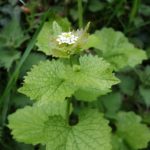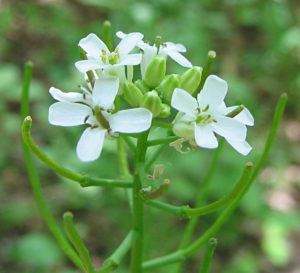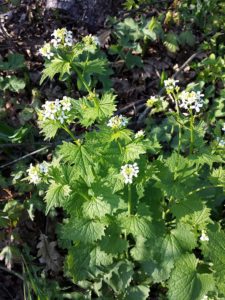
By Jeffrey North
Invasive plant species are disrupting ecosystems globally and here in Belmont. Biological invasions are a leading cause of biodiversity loss and even species extinction, and invasive plants are permanently altering the ecology of our forests, fields, and gardens.
This article is the first in a series on invasive plant species found in Belmont and the implications of their presence, spread, and ecological damage potential, as well as hopes for their removal and remediation.
Garlic mustard (Alliara petiolata) is changing the character of the woodlands in the Northeast. It can outcompete native herbaceous species, depriving the natives of light, moisture, nutrients, and space. It also adversely affects the mycorrhizal fungi (fungus which form a symbiotic relationship with the roots of a seed plant) that make up important underground networks, the “central nervous system” of a forest.
Fun Facts
- Garlic mustard was first recorded in the United States on Long Island in 1868, but it was likely introduced by colonial settlers for food or medicine much earlier.
- Sixty-nine insect species consume garlic mustard in its native range in Europe; none of those species live in North America.
- You will know it by its heart-shaped leaves.
- It smells like garlic when crushed.
- You can eat it.
The Invasive Plant Garlic Mustard
A visually attractive plant, garlic mustard prefers moist, shaded areas but it can be found in a variety of habitat types, including fields, upland forests in different stages of growth, floodplain forests and their edges, roadsides, along trails, and in your backyard and flower beds. Because of its shade tolerance, garlic mustard can dominate a forest understory.
The plant is a biennial. In the first year of growth, it is a basal rosette, when its growth is relatively slow. In its second year, growth is rapid as it reaches three feet or more during early spring. The plant is capable of cross- and self-pollination. The good news is that the plant only lives two years. The bad news is that each plant can produce thousands of seeds that can live for up to seven years in the soil.
Garlic mustard successfully invades woodlands and displaces native plants due to its ability to pollinate itself (a single plant can carpet a forest), its high seed production, and its rapid growth during the second growing season. Because of garlic mustard’s ability to colonize understory habitats, it may be impossible to eliminate the plant from large areas of habitat it has already invaded, but containment and control may be achievable.
The Problem
Why is garlic mustard a concern? In short, it is changing the ecosystem of New England as it invades and pervades new landscapes. This species is changing the character of woodlands as it displaces native edge and understory plants.
Garlic mustard, as well as other invasive plants, are leading suspects in the decline of insect populations and thus the decline of sustenance for birds. The impact of invasive plants on native plant biodiversity is increasingly seen as a major cause of insect population collapse among ecologists, although the idea is still controversial. No bugs, no birds. The result is a loss of biodiversity as garlic mustard outcompetes native plants for water, nutrients, sunlight, and space.
The effects go up and down the food chain as this invasive plant species toxifies the soil in ways that hamper the function of fungi and soil microbes that are critical for the germination of seedlings and the growth of trees.
Moreover, mycorrhizal fungi are increasingly recognized as key to connecting trees and plant networks for many types of communication for resources, defense, and kin recognition. Healthy mycorrhizal fungi enhance understory seedling survival and growth. Garlic mustard produces a host of chemicals that retard or halt the growth of the mycorrhizal fungi that are critical for the health of forests.
To compound the injury, garlic mustard contains chemical compounds that make the plant unpalatable to herbaceous insects and other creatures that would eat it. In short, garlic mustard has been shown to decrease native plant diversity, reduce native plant growth, decrease insect and butterfly survival, and alter nutrient cycling.
In Belmont, garlic mustard is easy to find. It appears in early spring along both sides of Mill Street between McLean Street and Concord Avenue. Volunteers in past years have pulled the plant at Rock Meadow in the area near Lorimer and Vernon Roads. At Lone Tree Hill, it will spring up near the parking lot, in the meadow near Mill Street, and along various paths. That is just a sample of invaded spots in Belmont.

Garlic mustard flowers and seed pods. Source:CC BY-SA 3.0, commons.wikimedia.org/w/index.php?curid=172767
The Solution
Pull it. Unlike some other invasive plant species, hand pulling can be effective in removing this shallow-rooted plant, preferably before it sheds its seeds into the soil.
The trick is to pull the plant, with its root, before the seed pods are ready to open. Grab the stem close to the root and gently tug. Organizations such as New England university extension programs and others advise that hand pulling is most effective in March through mid-May and again in September into October.
Once the plants are pulled, they should be bagged and sent to the landfill. Composting is a bad idea as it would just spread the seeds. Even burning the plants might not kill the seeds.
While complete eradication of the species from large parcels of land might be very ambitious, containment at sites the size of infestations found in Belmont should be achievable, even while avoiding chemicals. Garlic mustard can be treated chemically, but the best method of removal is to pull it in early spring and summer before the white blossoms turn to seed pods.
Garlic Mustard Pesto
Be sure to harvest wild plants where no chemicals have been sprayed.
3 tbsp. garlic mustard roots, chopped
4 garlic cloves, minced
1 cup wild garlic mustard leaves, chopped
¾ cup fresh parsley, minced
1 cup fresh basil leaves, diced
2 cups of walnuts, chopped
1/2 cup black olives, chopped
½ cup olive oil
½ cup yellow miso (if unavailable, add salt to taste)
Pulse all ingredients in a food processor until the mixture is finely ground. Serve as a spread for crackers or bread or as a pasta topping.
Adapted from K. A. Holbrook, National Park Service.
Jeffrey North is an ex officio Belmont Conservation Commission representative on the Land Management Committee for Lone Tree Hill, and managing editor of the Belmont Citizens Forum Newsletter.




Sorry, the comment form is closed at this time.